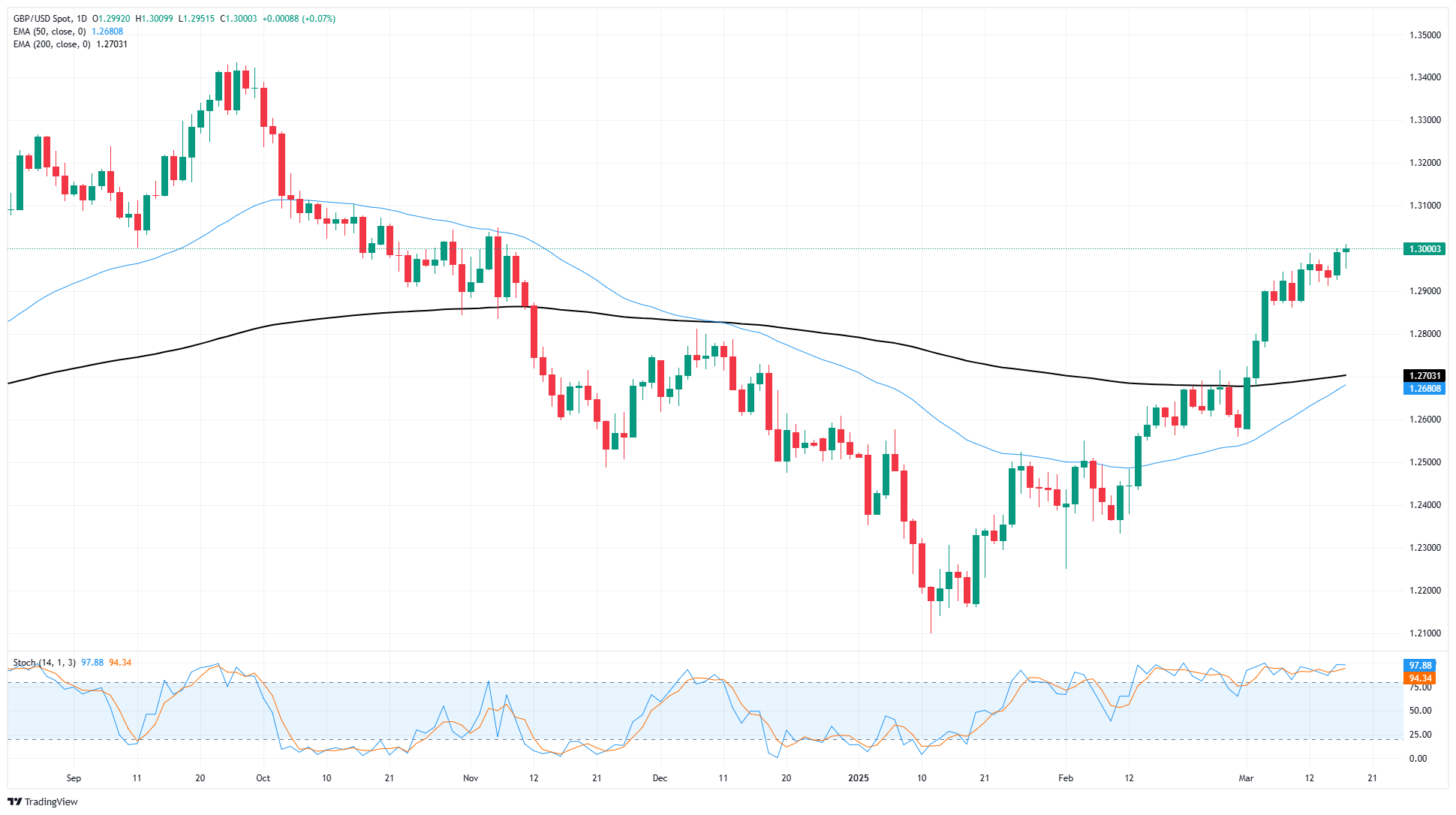- GBP/USD pushed back into the 1.3000 handle on Tuesday.
- Markets are buckling up for a one-two punch of Fed and BoE rate calls.
- The Fed is expected to hold steady on rates until April, BoE also seen steady.
GBP/USD traded thinly on Tuesday, but still inched back into the 1.3000 handle, chalking in a fresh 19-week high ahead of high-impact rate calls from both the Federal Reserve (Fed) and the Bank of England (BoE). The Fed is widely expected to hold steady on rates this week, but a fresh update to the Federal Open Market Committee’s (FOMC) interest rate expectations will draw plenty of eyes.
The Federal Reserve’s (Fed) latest rate call is due on Wednesday. According to the CME’s FedWatch Tool, rate markets broadly anticipate the Fed to stand pat on rates for the next two meetings, with the next quarter-point rate trim expected at the Federal Open Market Committee’s (FOMC) June meeting. However, the FOMC’s latest interest rate forecasts will be released this week. They could send rate cut expectations through the wringer if Fed policymaker’s expectations for interest rates deviate wildly from current market forecasts.
The BoE’s upcoming rate call on Thursday will draw some Cable traders’ attention, but not nearly as much as the Fed’s showing during the midweek market session. After the BoE’s latest rate cut last month, the UK’s central bank is expected to vote 7-to-2 to keep rates unchanged at 4.5%, with two particularly dovish policymakers expected to vote for another quarter-point cut.
GBP/USD price forecast
GBP/USD is testing into its third straight week of gains, clipping back into the 1.3000 handle for the first time since last November. The pair is now trading 7.5% above January’s multi-month low of 1.2100. Near-term price action is still tilted firmly in favor of Cable bulls, however GBP/USD may have overextended itself as technical oscillators remain pinned deep in overbought territory.
GBP/USD daily chart
Pound Sterling FAQs
The Pound Sterling (GBP) is the oldest currency in the world (886 AD) and the official currency of the United Kingdom. It is the fourth most traded unit for foreign exchange (FX) in the world, accounting for 12% of all transactions, averaging $630 billion a day, according to 2022 data. Its key trading pairs are GBP/USD, also known as ‘Cable’, which accounts for 11% of FX, GBP/JPY, or the ‘Dragon’ as it is known by traders (3%), and EUR/GBP (2%). The Pound Sterling is issued by the Bank of England (BoE).
The single most important factor influencing the value of the Pound Sterling is monetary policy decided by the Bank of England. The BoE bases its decisions on whether it has achieved its primary goal of “price stability” – a steady inflation rate of around 2%. Its primary tool for achieving this is the adjustment of interest rates. When inflation is too high, the BoE will try to rein it in by raising interest rates, making it more expensive for people and businesses to access credit. This is generally positive for GBP, as higher interest rates make the UK a more attractive place for global investors to park their money. When inflation falls too low it is a sign economic growth is slowing. In this scenario, the BoE will consider lowering interest rates to cheapen credit so businesses will borrow more to invest in growth-generating projects.
Data releases gauge the health of the economy and can impact the value of the Pound Sterling. Indicators such as GDP, Manufacturing and Services PMIs, and employment can all influence the direction of the GBP. A strong economy is good for Sterling. Not only does it attract more foreign investment but it may encourage the BoE to put up interest rates, which will directly strengthen GBP. Otherwise, if economic data is weak, the Pound Sterling is likely to fall.
Another significant data release for the Pound Sterling is the Trade Balance. This indicator measures the difference between what a country earns from its exports and what it spends on imports over a given period. If a country produces highly sought-after exports, its currency will benefit purely from the extra demand created from foreign buyers seeking to purchase these goods. Therefore, a positive net Trade Balance strengthens a currency and vice versa for a negative balance.
Information on these pages contains forward-looking statements that involve risks and uncertainties. Markets and instruments profiled on this page are for informational purposes only and should not in any way come across as a recommendation to buy or sell in these assets. You should do your own thorough research before making any investment decisions. FXStreet does not in any way guarantee that this information is free from mistakes, errors, or material misstatements. It also does not guarantee that this information is of a timely nature. Investing in Open Markets involves a great deal of risk, including the loss of all or a portion of your investment, as well as emotional distress. All risks, losses and costs associated with investing, including total loss of principal, are your responsibility. The views and opinions expressed in this article are those of the authors and do not necessarily reflect the official policy or position of FXStreet nor its advertisers. The author will not be held responsible for information that is found at the end of links posted on this page.
If not otherwise explicitly mentioned in the body of the article, at the time of writing, the author has no position in any stock mentioned in this article and no business relationship with any company mentioned. The author has not received compensation for writing this article, other than from FXStreet.
FXStreet and the author do not provide personalized recommendations. The author makes no representations as to the accuracy, completeness, or suitability of this information. FXStreet and the author will not be liable for any errors, omissions or any losses, injuries or damages arising from this information and its display or use. Errors and omissions excepted.
The author and FXStreet are not registered investment advisors and nothing in this article is intended to be investment advice.
Recommended content
Editors’ Picks

EUR/USD trims some gains, recedes to 1.1350
Despite losing some upside momentium, EUR/USD keeps the firm tone around the mid-1.1300s on Thursday, buoyed by renewed US Dollar weakness as investors grappled with the continued stalemate in US–China trade negotiations.

GBP/USD puts the 1.3300 level to the test
GBP/USD hovers around the 1.3300 area on Thursday, supported by a broad rebound in risk-sensitive assets, renewed weakness in the Greenback and lingering uncertainty over US–China trade talks.

Gold sticks to the bullish stance near $3,330
On Thursday, gold regained lost ground after two consecutive days of declines, with XAU/USD climbing back toward $3,300 per troy ounce following an earlier rally to roughly $3,370. The metal drew safe-haven buying as renewed fears of a US–China trade flare-up weighed on broader markets.

Bitcoin Price corrects as increased profit-taking offsets positive market sentiment
Bitcoin (BTC) is facing a slight correction, trading around $92,000 at the time of writing on Thursday after rallying 8.55% so far this week. Institutional demand remained strong as US spot Exchange Traded Funds (ETFs) recorded an inflow of $916.91 million on Wednesday.

Five fundamentals for the week: Traders confront the trade war, important surveys, key Fed speech Premium
Will the US strike a trade deal with Japan? That would be positive progress. However, recent developments are not that positive, and there's only one certainty: headlines will dominate markets. Fresh US economic data is also of interest.

The Best brokers to trade EUR/USD
SPONSORED Discover the top brokers for trading EUR/USD in 2025. Our list features brokers with competitive spreads, fast execution, and powerful platforms. Whether you're a beginner or an expert, find the right partner to navigate the dynamic Forex market.



